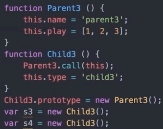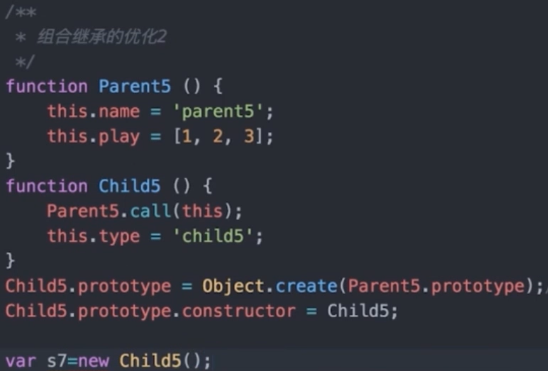详解原型链,面向对象(下)
2017-12-14 10:39
120 查看
接上文:
1.类的声明
2.生成实例 new Animal(),new Animal2,如果new的时候没有参数,也可以不加括号
3.继承的实现
>call方法(通过构造函数实现继承)

缺点:无法继承来自Parent1的原型上的东西,只能部分继承
>原型链继承

缺点:
改变了s1的属性同时也会影响到s2,因为原型链中的原型对象是公用的
注:实际上new出来的新类.name是不存在的,通过查找新类.__proto__.name才会有,所以是在原型链上查找出来的
>组合方式(企业通用方法)

缺点:new 2次,构造函数被执行了2次
第一次:s3的new时候 Child3的构造函数被执行了一次
第二次:Child3的原型new Parent3的时候
注:其实s3和s4分别有两套name和play,一份是call出来的,使用时直接s3.name,可以得出,一份是原型链上的s3.__proto__.name可以得出,该方法只是在call的基础上把parent的原型链继承给了Child3而已
>优化

缺点:constroctor指向父类
>优化
测试过程中也可以
将constructor设置回来即可,但是父类和子类的
constructor都变成子类了
>终极优化

var o=Object.create(parent)是把参数parent当做原型对象传给o的,所以o并不具备parent的属性,但是o的__proto__具有,因为o.__proto__===parent
总结:原型链继承由于new的时候是把原型对象上的属性复制给新对象,于是新对象相当于有两个相同属性,如果新对象为o,那么他既有o.name,又有o.__proto__.name,修改两个的时 候互不影响,但是会影响原型链就是原型对象的.prototype,继而影响所有new出来的新对象
如有错误,请多指正
1.类的声明
function Animal (){
this.name="name";
}
es6:
class Animal2{
constructor(){
this.name="name";
}
}2.生成实例 new Animal(),new Animal2,如果new的时候没有参数,也可以不加括号
3.继承的实现
>call方法(通过构造函数实现继承)

缺点:无法继承来自Parent1的原型上的东西,只能部分继承
>原型链继承

缺点:
改变了s1的属性同时也会影响到s2,因为原型链中的原型对象是公用的
注:实际上new出来的新类.name是不存在的,通过查找新类.__proto__.name才会有,所以是在原型链上查找出来的
>组合方式(企业通用方法)

缺点:new 2次,构造函数被执行了2次
第一次:s3的new时候 Child3的构造函数被执行了一次
第二次:Child3的原型new Parent3的时候
注:其实s3和s4分别有两套name和play,一份是call出来的,使用时直接s3.name,可以得出,一份是原型链上的s3.__proto__.name可以得出,该方法只是在call的基础上把parent的原型链继承给了Child3而已
>优化

缺点:constroctor指向父类
>优化
测试过程中也可以
function Parent4 () {
this.name = 'parent4';
this.play = [1, 2, 3];
}
function Child4 () {
Parent4.call(this);
this.type = 'child4';
}
Child4.prototype = Parent4.prototype;
Child4.prototype.constructor=Child4;
var s5 = new Child4();
var s6 = new Child4();
console.log(s5, s6);
console.log(s5 instanceof Child4, s5 instanceof Parent4);
console.log(s5.constructor);将constructor设置回来即可,但是父类和子类的
constructor都变成子类了
>终极优化

var o=Object.create(parent)是把参数parent当做原型对象传给o的,所以o并不具备parent的属性,但是o的__proto__具有,因为o.__proto__===parent
总结:原型链继承由于new的时候是把原型对象上的属性复制给新对象,于是新对象相当于有两个相同属性,如果新对象为o,那么他既有o.name,又有o.__proto__.name,修改两个的时 候互不影响,但是会影响原型链就是原型对象的.prototype,继而影响所有new出来的新对象
如有错误,请多指正
相关文章推荐
- 前端基础进阶(九):详解面向对象、构造函数、原型与原型链
- 详解原型链,面向对象(上)
- 前端基础进阶(七):详解面向对象、构造函数、原型与原型链
- 详解面向对象、构造函数、原型与原型链
- Javascript 面向对象详解-转
- javascrpt 类详解 面向对象
- PHP面向对象五大原则之里氏替换原则(LSP)详解
- 面向对象的三个基本特征详解
- 面向对象(六)之内部类详解
- JS 面向对象之继承 -- 原型链
- javascript原型深入解析1-prototype 和原型链、js面向对象
- 连载:面向对象葵花宝典:思想、技巧与实践(10) - “抽象” 详解
- JavaScript-- prototype原型和原型链详解
- 51_面向对象_24_内部类详解
- PHP面向对象五大原则之开放-封闭原则(OCP)详解
- 架构师之路(4)---详解面向对象
- 连载:面向对象葵花宝典:思想、技巧与实践(11) - “封装” 详解
- Java中面向对象的详解
- 架构师之路(4)---详解面向对象 王泽宾
- java之面向对象:子类对象的实例化过程详解
